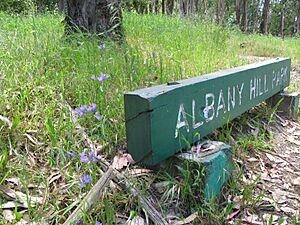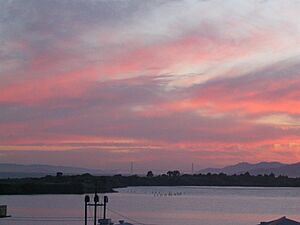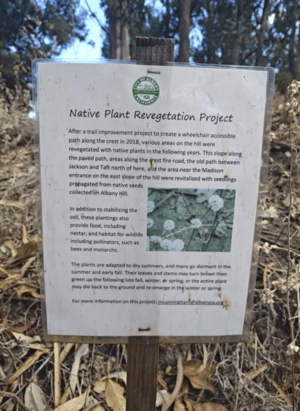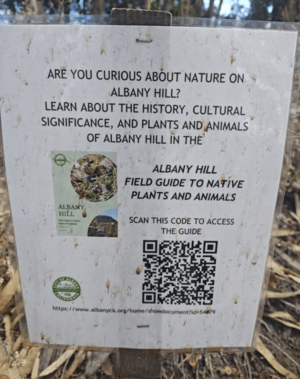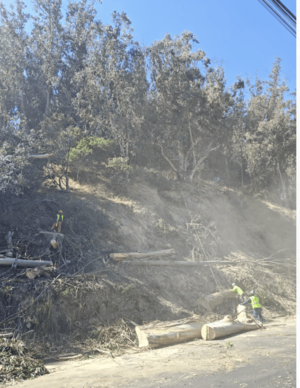Albany Hill facts for kids
Quick facts for kids Albany Hill |
|
|---|---|
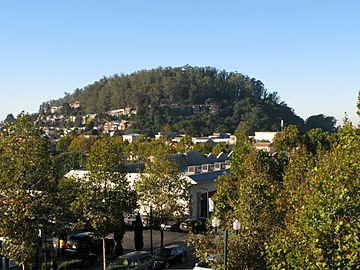
Albany Hill from El Cerrito Plaza BART station
|
|
| Highest point | |
| Elevation | 338 ft (103 m) NGVD 29 |
| Geography | |
| Location | Alameda County, California, U.S. |
| Topo map | USGS Richmond |
Albany Hill is a noticeable hill located along the eastern shore of San Francisco Bay. You can find it in the city of Albany, California.
This hill is mostly made of sandstone from a very long time ago, during the Jurassic period. This rock traveled across the ocean on a giant plate of the Earth's crust. Albany Hill is part of an older group of hills, formed long before the Berkeley Hills we see today.
The original name for Albany Hill, given by the Ohlone people who lived there, is not known. Later, in 1772, explorers called it "El Cerrito." The Luís María Peralta family then named it Cerrito de San Antonio after their large ranch. The name changed to Albany Hill in 1909 when the nearby city became Albany. The city of El Cerrito got its name from the hill's original Spanish name.
Contents
A Look into Albany Hill's Past
The northern side of Albany Hill was a home for the Chochenyo Ohlone people for a long time. We know this because of large grinding stones and old shell piles found there. The area was rich with oak trees, a willow grove, and wetlands, making it a great place to live seasonally.
Later, in the late 1800s, a company that made dynamite moved near Albany Hill. They planted the eucalyptus trees you see today. These trees were meant to catch debris and quiet the sounds of any explosions. There were several explosions over the years. The train stop nearby was even called Nobel Station, after Alfred Nobel, who invented dynamite.
In 1905, a huge explosion happened, which stopped the making of explosives on the hill. Quarrying, which is digging out rock, continued for many years. This left marks on the hill and even removed a smaller peak nearby.
Amazing Nature and Wildlife
Albany Hill is like a special island for nature. It's a large open space right next to the Bay and gets cool winds from the ocean. This makes it a perfect home for plants usually found in colder places, like Nootka rose.
For many years, people would regularly burn parts of the hill to prevent big fires. This might be why the hill has so many native wildflowers and other plants. The oak forest on the cool north side looks much like it did before European settlers arrived. The non-native eucalyptus trees at the top attract monarch butterflies that are migrating or spending the winter.
Many animals live on Albany Hill. You might see hawks, Great Horned owls, wild turkeys, and hummingbirds. There are also striped skunks, black-tailed deer, and even western forest scorpions. In the creek, you can spot mallard ducks, herons, kingfishers, and egrets. Coyotes are sometimes seen too.
A guide called the Albany Hill Field Guide was created in 2023. It shares information about the hill's history and nature. Some plants found there include:
- Grasses: Blue Wild Rye and Purple Needle Grass.
- Trees and Shrubs: California Hazelnut, Coast Live Oak, and Poison Oak.
- Herbaceous Plants: California Goldenrod, California Mugwort, and Sticky Monkey Flower.
Other interesting creatures found on the hill include:
- Lichens: Flavoparmelia caperata.
- Fungi: Lion’s mane and butter and eggs.
- Butterflies: Common checkered skipper and anise swallowtail.
- Insects: Green sweat bee and velvety tree ant.
- Reptiles and Amphibians: Slender salamander, California alligator lizard, and ring-necked snake.
Protecting Albany Hill Today
From Albany Hill, you can see amazing views of Albany, Berkeley (including UC Berkeley's Sather Tower), and the Berkeley Hills. If you look towards the Bay, you can see San Francisco in the distance. To the south, you can spot the tall buildings of downtown Oakland and Emeryville. People have always enjoyed the open space on the hill, even "sledding" on dry grass.
For many years, people wanted to build on Albany Hill. Ideas ranged from digging it up to fill the Bay to building tall hotels. But local residents protested and stopped most of these plans. Eventually, the city decided to protect most of the hill. They allowed some clustered tall residential buildings, but kept the majority of the hill as open space.
In 1994, citizens voted for Measure K, which cut the allowed building density on the hill by half. In 1996, voters passed Measure R, which included $3 million to buy land on the hill. By 2019, the city had bought about six acres of land. The remaining money was used to improve access and other features for the park.
Today, almost three-quarters of the hill's nearly 40 acres of open space are protected. A public park runs up the north side of the hill. Some large apartment buildings on the west side also keep significant areas as open space. The city owns part of the summit and northeast slope.
There is still one large private piece of land, about 10.7 acres, on the south side of the hill. Most people use this land like a park, but the city does not officially own a path for public access. This land was listed for sale in late 2019. The city's plan for the hill includes keeping the summit open, protecting monarch butterfly homes, and restoring the hill's natural features.
Fire Safety on Albany Hill
Because Albany Hill is covered in trees and surrounded by homes, fires are a big worry. Plans from 1991 and 2012 suggested thinning out eucalyptus trees and controlling brush. This would create a more open, grassy area that helps prevent large fires. On November 15, 2008, strong winds caused a fire on the west side of the hill. Luckily, heavy rain and quick action by fire departments limited the fire to about 2 acres, and no buildings were harmed.
More recently, on June 26, 2022, another vegetation fire started on the west side of Albany Hill. Residents in nearby streets were asked to leave their homes for a short time. The fire was quickly put out, and no one was hurt. Because of past fires, the city has increased efforts to control brush and maintain roads. However, they also want to protect the homes of birds and monarch butterflies that use the eucalyptus trees.
In October 2021, the Albany City Council started a project called The Albany Hill Eucalyptus Project. This project aims to improve the health of the eucalyptus trees and reduce fire risk. In September 2022, the city received a grant to help with this project. The city also released a plan to remove eucalyptus trees and plant native grasses and oaks instead. In September 2024, some large eucalyptus trees that were a safety risk were removed by the city.
Currently, the city's Public Works and Fire Departments keep an eye on safety on the hill. Volunteer groups also help. Friends of Albany Hill works to plant more native plants and remove invasive ones. They also teach people about the hill's importance, watch over the monarch butterflies, and improve trails. Friends of Five Creeks helps restore the creeks and meadows at the base of the hill. A newer group, TASH (Tending the Ancient Shoreline Hill), started in 2018 to continue restoring nature and educating the public. They hold monthly work parties.
The Lions Club Cross
A 20-foot tall cross was put up near the top of Albany Hill in 1971 by the Albany Lions Club. At that time, the land was private. The city bought the land in 1973. The Lions Club used to light up the cross on holidays like Christmas and Easter, and for events like the anniversary of the September 11 attacks.
Over the years, there were discussions about whether a Christian symbol should be on public land. In 2016, the city turned off the power to the cross due to safety concerns about the electrical wires. In June 2018, a judge decided that the cross on public land was against the rules. The judge said the city had to remove the cross or sell the land it was on. The cross was removed by the city on June 8, 2023. The Lions Club tried to appeal this decision, but their appeal was denied. In October 2024, the city agreed to pay the Lions Club $1.53 million for the right to remove the cross.
See also
- Sala House




